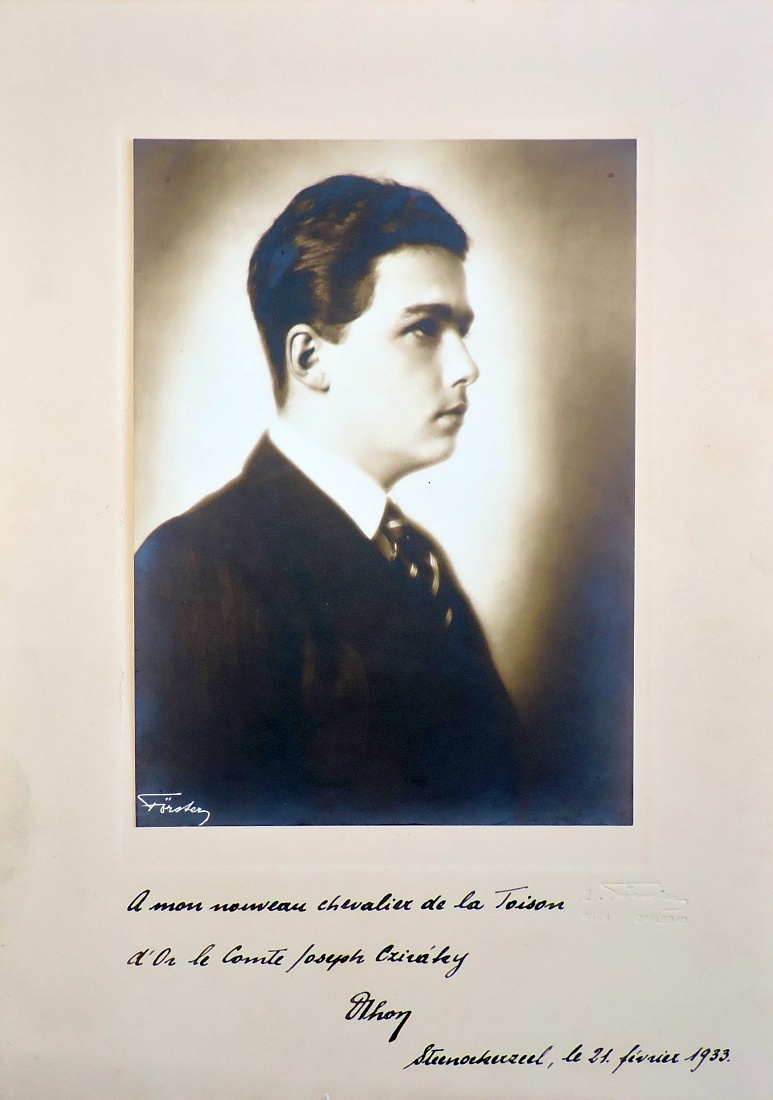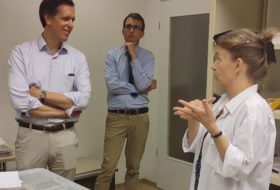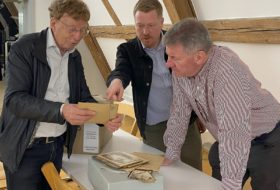At the initiation of new members of the Order of the Golden Fleece.
Otto, as Grand Master of the Order, stands in the centre in his traditional Hungarian ceremonial attire,
József Cziráky, third from the right, wearing the neck ornament of the Order with the Order’s insignia on it:
A golden ram’s skin hanging from a blue enamelled flame-spreading firestone (1933)
Our Foundation considers it essential to explore the life of Otto von Habsburg and his network of contacts in other collections, thus contributing to a more complete picture of the exceptionally rich life of the last Hungarian heir to the throne. On 8 November 2023, we had the opportunity to explore the surviving fragments of the Cziráky family collection in the research room of the National Archives of Hungary Győr-Moson-Sopron County Sopron Archives. Among the examined documents, a box containing the family photo albums revealed a photo card with a note of congratulation from Otto von Habsburg, taken in 1932 in Belgium, on the occasion of József Cziráky’s admission to the Order of the Golden Fleece. On reaching his majority in 1930, Otto became Grand Master of the Knightly Order of the Golden Fleece. Founded in 1429 to defend the Christian faith and the Catholic Church, the Order’s history was intertwined with that of the Habsburg dynasty, and its members were Catholic nobles and royals. The necklace symbolised the fundamental ideals of equality and fraternity between the secular Order of Knights members, which could only form a unified whole if they were linked together. Membership of the Order of the Golden Fleece was experienced by its members as a strong, explicitly sacred bond.
|
“To my new Knight of the Golden Fleece, Count József Cziráky.” |
During our research trip, on the same afternoon, we conducted a nearly two-hour oral history interview with László Erdődy, a member of the county family with many ties to the Habsburs, who, in the course of the conversation, suddenly began to recount the story of József Cziráky’s neck ornament. According to him, his father, Ferenc Erdődy, took the photograph in 1957 of the old Count (“Uncle Cziráky”) that we previously published, and as reported by the family memoirs, he even played a part in smuggling the ornament out of the country. László Erdődy’s father, who had emigrated to Germany in 1956, was granted permission to travel abroad from the 1960s onwards periodically, and on one of these occasions, he smuggled out the collar of the Golden Fleece and handed it over to Otto von Habsburg in Munich.
The contraband necklace trafficking has been preserved as part of two stories, one immediately after the events by Cziráky’s widow and the other by the Erdődy family memory. It is plausible that Ilona Andrássy, the widow, could have smuggled the necklet of the Golden Fleece, while Ferenc Erdődy could have delivered another souvenir to Otto von Habsburg, which belonged to the Cziráky family and was linked to the ruling family. Over time, these events have become a single story in the family’s recollections.
The research trip to West Hungary and the new insights uncovered and learned are prime examples of the significance of investigating and interpreting an event from as many perspectives and sources as possible.
István Gergely Szűts
Szilveszter Dékány



